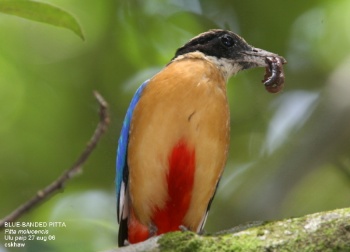- Pitta moluccensis
Alternative name: Moluccan Pitta; Lesser Blue-winged Pitta; Little Blue-winged Pitta
Identification
18-20cm (7-7¾ in)
- Blackish head with broad buffy brown sides of crown and buffy supercilium
- Dark green upperparts
- Turquoise-blue rump
- Black tail with blue-green tip
- Turquoise-blue inner half of wing, black primaries with broad white band
- White throat
- Cinnamon-buff rest of underparts with crimson centre of belly to undertail-coverts
- Blackish bill
Sexes similar. Juveniles lack the red belly patch.
Similar Species
It looks similar to the Mangrove Pitta but has a much more prominent supercilium, brighter colours and a smaller bill.
Distribution
Breeds from eastern and southern Burma and southern China (southern Yunnan) to Thailand, Laos, Cambodia, Vietnam and northern peninsular Malaysia.
Winters further south to Sumatra and Borneo (where possibly breeds).
Widespread and fairly common to locally common in suitable habitat.
Taxonomy
A monotypic species.
Formerly considered conspecific with Mangrove Pitta and Elegant Pitta. Forms a superspecies with Mangrove Pitta, Fairy Pitta and Indian Pitta.
Habitat
Edge of moist lowland evergreen forests, orchards and gardens. Also in mangroves and even in parks.
Behaviour
Diet
Their diet consists of ants, worms, crickets, grasshoppers and a variety of insects.
Forages on the ground and uses stones as anvils when cracking snail shells.
Breeding
Breeding season from April to August. They build a dome shaped nest on the ground in low undergrowth, from dried material and roots. It's usually placed on the ground. The clutch contains three to seven lightly speckled eggs which are incubated by both parents for 7-10 days.
References
- Clements, J. F., T. S. Schulenberg, M. J. Iliff, D. Roberson, T. A. Fredericks, B. L. Sullivan, and C. L. Wood. 2018. The eBird/Clements checklist of birds of the world: v2018. Downloaded from http://www.birds.cornell.edu/clementschecklist/download/
- Dickinson, EC, ed. 2003. The Howard and Moore Complete Checklist of the Birds of the World. 3rd ed., with updates to October 2008 (Corrigenda 8). Princeton: Princeton Univ. Press. ISBN 978-0691117010
- Gill, F and D Donsker (Eds). 2010. IOC World Bird Names (version 2.7). Available at http://www.worldbirdnames.org/.
- Del Hoyo, J, A Elliot, and D Christie, eds. 2003. Handbook of the Birds of the World. Volume 8: Broadbills to Tapaculos. Barcelona: Lynx Edicions. ISBN 978-8487334504
- BF Member observations
Recommended Citation
- BirdForum Opus contributors. (2025) Blue-winged Pitta. In: BirdForum, the forum for wild birds and birding. Retrieved 13 May 2025 from https://www.birdforum.net/opus/Blue-winged_Pitta
External Links
GSearch checked for 2020 platform.1







